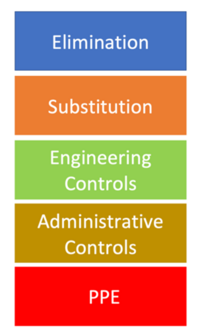“Everything in life has some risk. What you have to actually learn to do is how to navigate it.” - Reid Hoffman
From the moment you wake up in the morning, you are constantly assessing levels of risk and implementing controls to remove or reduce the risk involved in that activity.
Let’s consider the morning commute. It is quite possible that it will still be dark outside. There is therefore a risk of you having an accident as a result of the lack of visibility, due to the reduction in the amount of light available when driving. However, this risk is reduced when you turn on your car headlights, as this mechanical light aids in providing you with more light, therefore providing you with an increased visibility of your surroundings whilst you drive.
Whilst the above all seems straight forward, we see that many people struggle with the concept of Risk Assessment, especially when these need to be written down.
This article will therefore provide you with the information on why we need to conduct Risk Assessment, along with the 5 steps which you need to follow, in order to produce a suitable and sufficient risk assessment.
What is a Risk Assessment?
A Risk Assessment is the systematic process of evaluating the potential risks that may be involved in a particular activity or undertaking.
Why do we need to conduct a Risk Assessment?
Risk Assessments are a vital tool in the management of Health and Safety for your business, as it allows for the documentation of risks that your workforce is being exposed to, along with the controls which need to be implemented in order to eliminate or reduce this risk.
From a legal perspective, as an employer, you are required to protect your employees and others from harm. Under the Management of Health and Safety at Work Regulations 1999, the minimum you must do is:
- Identify what could cause injury or illness in your business (known as hazards)
- Decide how likely it is that someone could be harmed and how seriously (known as risk)
- Take action to eliminate the hazard, or if this isn’t possible, control the risk
If, as an organisation, you have fewer than 5 employees, you do not have to write a Risk Assessment down. However, it is useful to do so, so that you can review it at a later date. Alternatively, if you have more than 5 employees, you are required by law to write it down.
Should you as an organisation fail to conduct a risk assessment in respect of a particular activity or undertaking, you are not only exposing your workforce to the risks associated with it, but if you have more than 5 employees, you will also be breaking the law.
Case study
The HSE reported that a recycling company had been fined after one of its employees was injured whilst clearing a blockage in a waste metal chute.
The Court heard how the employee was injured when he fell through a chute, approximately 4 meters above a concrete yard. Another employee, who was waiting in a telescopic handler to collect the waste metal in the machines bucket, moved the machine to try and catch him. The employee was hit by the bucket and sustained numerous injuries.
The HSE found that there was no risk assessment or safe system of work in place. Therefore, the company had not considered the risk of employees falling through the chute from that height. The company in question were found guilty of breaching Section 2(1) of the Health and Safety at Work Act 1974 and were fined £17,500.
5 steps to completing a Risk Assessment
Now we know what a risk assessment is and why they are needed, we will now turn our attention to the how you complete a risk assessment. There are 5 steps which need to be completed in order for a risk assessment to be produced
Step 1 – Identify the Hazards
Workplaces will have a myriad of risks associated with the tasks being undertaken by that organisation. It is therefore of vital important to take your time to gather all of the relevant hazards within your workplace. There are numerous ways in which hazards can be identified within your workplace:
- Conduct a walkaround – walking around allows you to visually spot any hazards that are present in your workplace.
- Speak with members of staff – this is vital, as members of staff will be able to inform you of the individual hazards which are present in the work they carry out.
- Check manufacturer’s instructions – manufacturers of machinery, equipment and chemicals will often provide you with information on the hazards associated with the product.
- Reactive Health and Safety data – this is data on such things as accidents and ill-health records. This will provide you with information on hazards which have resulted in previous accidents.
- Speak with other companies in your industry – if possible, speak with other companies to see what risks they have identified, as these may be similar to the hazards in your organisation.
Step 2 – Decide who might be harmed
For each of the hazards that you have identified, you need to think who might be harmed and how. This will provide you with useful information which can be used in order to consider the best way of controlling the risk.
When deciding who might be harmed, you do not have to personally list every individual, but rather have to classify people certain categories. The following are some categories which could apply to your workplace:
- Visitors/Contractors
- Specific workers (i.e., young persons, pregnant workers)
- Members of the public
Step 3 – Evaluate the Risks
Once you have identified the hazards and considered who might be harmed, you need to decide how likely it is that the identified harm will occur and what you intend to do to reduce the likelihood and severity associated with the hazard.
You are not expected to eliminate all risks, as this is not possible. However, you are to do everything that is 'reasonably practicable’ to protect those identified. To do this, you must balance the level of risk against control measures needed to control the risk. You do not need to take action if it would be grossly disproportionate to the level of risk.
Consultation with employees during the risk assessment process is crucial, specifically when it comes to evaluating the risks of certain activities, as the staff undertaking these tasks will be able to provide you with a detailed evaluation of the risk, along with potential control measures they believe will assist in reducing the risk.
Hierarchy of Risk Control
When deciding on the right control measures associated with a risk, you should consider the hierarchy of risk control.
The hierarchy provides a pyramid approach to control measures, starting with the most important at the top, with PPE being a last resort.
Step 4 – Record your findings and implement them
Now that you have confirmed what control measures you are going to implement, you need to record your findings in a risk assessment document. If you have fewer than five employees, you don’t have to write anything down. However, it may be useful as you can review it at a later date.
If you are unsure what a risk assessment document looks like, the Health and Safety Executive have provided templates which can be used as a starting point. If you would like to access the risk assessment template, please click here.
The HSE confirm that a risk assessment must be ‘suitable and sufficient’. To comply with this, the Risk Assessment should show that you checked the workplace, identified the relevant hazards associated with the workplace and its activities and the people that could be affected, along with implementing reasonable control measures to reduce the risk.
Step 5 – Regular review and update
Implementing a risk assessment review process is a vital tool and is something which can quite easily be overlooked. Many people assume that once a risk assessment has been compiled that the process is completed. This is not true, as no workplace remains the same over time.
As technology advances, an organisation may decide to bring in new equipment to undertake a particular activity. Furthermore, new substances and procedures might be introduced, which all lead to the potential for additional hazards in the workplace. Finally, there may be legislative changes which result in additional controls needed to protect those who could be affected by the risks in workplace.
A review process captures any new hazards which are present as a result of these changes, you can then adopt stages 1 – 4 outlined above, to ensure that you are keeping your workforce safe.
Make sense?
We hope that the contents of this article make sense, and that you are now fully equipped to complete your own risk assessments. Just remember to take your time and follow the 5 steps contained within this document and you will be fine.
Author Bio
Universal Safety Practitioners – A Health and Safety Consultancy company based in West Sussex.